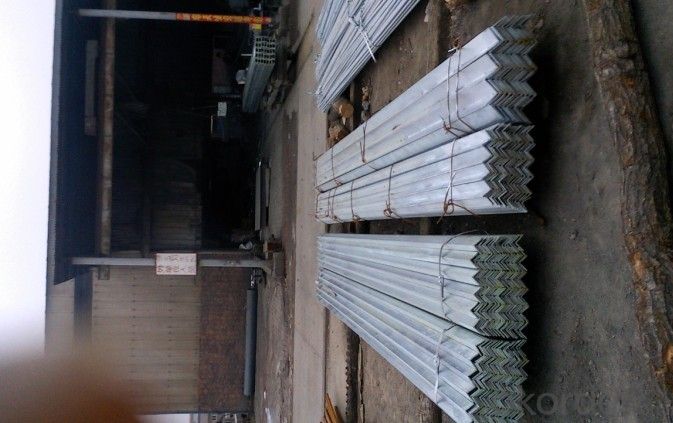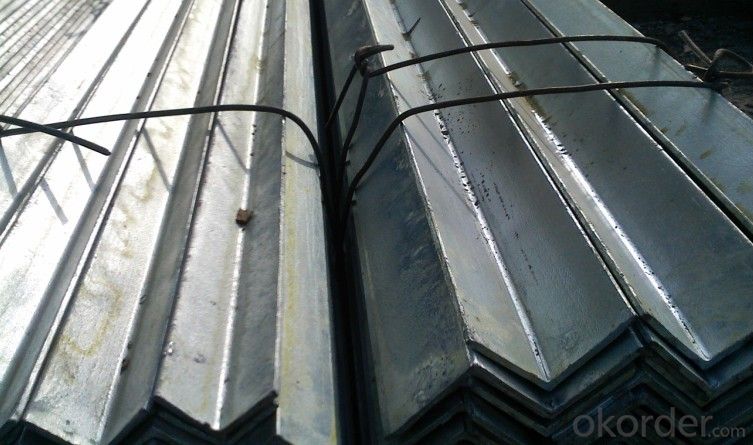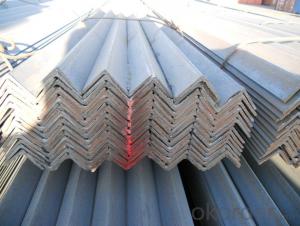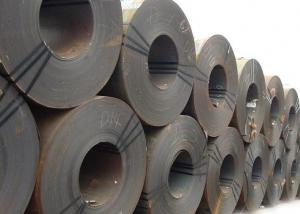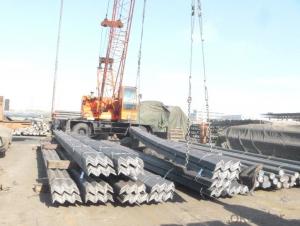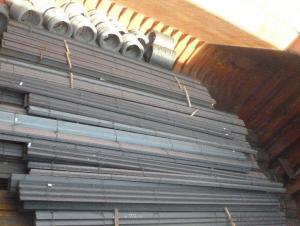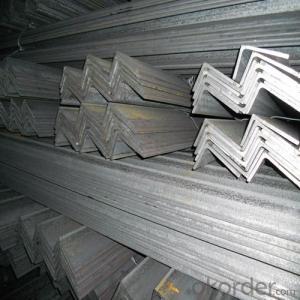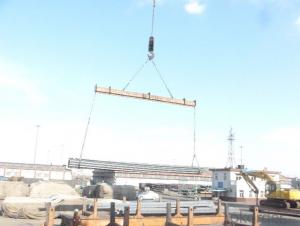hot rolled angle steel JIS 50MM*50MM 6M
- Loading Port:
- Qingdao
- Payment Terms:
- TT OR LC
- Min Order Qty:
- 50 m.t.
- Supply Capability:
- 10000 m.t./month
OKorder Service Pledge
OKorder Financial Service
You Might Also Like
Product Description:
Specifications of Angle Steel
1. Invoicing on theoretical weight or actual weight as customer request
2. Length: 6m, 9m, 12m as following table
3. Sizes
Sizes: 25mm-250mm | ||
a*t | ||
25*2.5-4.0 | 70*6.0-9.0 | 130*9.0-15 |
30*2.5-6.6 | 75*6.0-9.0 | 140*10-14 |
36*3.0-5.0 | 80*5.0-10 | 150*10-20 |
38*2.3-6.0 | 90*7.0-10 | 160*10-16 |
40*3.0-5.0 | 100*6.0-12 | 175*12-15 |
45*4.0-6.0 | 110*8.0-10 | 180*12-18 |
50*4.0-6.0 | 120*6.0-15 | 200*14-25 |
60*4.0-8.0 | 125*8.0-14 | 250*25 |
5. Payment terms:
1).100% irrevocable L/C at sight.
2).30% T/T prepaid and the balance against the copy of B/L.
3).30% T/T prepaid and the balance against L/C
6.Material details:
Alloy No | Grade | Element (%) | |||||
C | Mn | S | P | Si | |||
|
|
|
|
|
|
| |
Q235 | B | 0.12—0.20 | 0.3—0.7 | ≤0.045 | ≤0.045 | ≤0.3 | |
|
|
|
|
|
|
| |
Alloy No | Grade | Yielding strength point( Mpa) | |||||
Thickness (mm) | |||||||
≤16 | >16--40 | >40--60 | >60--100 | ||||
≥ | |||||||
|
|
|
|
|
| ||
Q235 | B | 235 | 225 | 215 | 205 | ||
Alloy No | Grade | Tensile strength (Mpa) | Elongation after fracture (%) | ||||
Thickness (mm) | |||||||
| ≤16 | >16--40 | >40--60 | >60--100 | |||
≥ | |||||||
|
|
|
|
|
|
| |
Q235 | B | 375--500 | 26 | 25 | 24 | 23 | |
Usage & Applications of Angle Steel
According to the needs of different structures, Angle can compose to different force support component, and also can be the connections between components. It is widely used in various building structures and engineering structures such as roof beams, bridges, transmission towers, hoisting machinery and transport machinery, ships, industrial furnaces, reaction tower, container frame and warehouse etc.
Packaging & Delivery of Angle Steel
1. Packing: it is nude packed in bundles by steel wire rod
2. Bundle weight: not more than 3.5MT for bulk vessel; less than 3 MT for container load
3. Marks:
Color marking: There will be color marking on both end of the bundle for the cargo delivered by bulk vessel. That makes it easily to distinguish at the destination port.
Tag mark: there will be tag mark tied up on the bundles. The information usually including supplier logo and name, product name, made in China, shipping marks and other information request by the customer.
If loading by container the marking is not needed, but we will prepare it as customer request.
Production flow of Angle Steel
Material prepare (billet) —heat up—rough rolling—precision rolling—cooling—packing—storage and transportation
- Q: What are the different grades of steel used for angles?
- The different grades of steel used for angles can vary depending on the specific application and requirements. However, some common grades of steel used for angles include A36, A572, and A588. A36 steel is a low carbon steel that is commonly used in structural applications. It has good weldability and machinability, making it a versatile choice for angles. A36 steel angles are often used in construction, manufacturing, and general fabrication projects. A572 steel is a high-strength, low-alloy structural steel that is commonly used in structural applications such as bridges, buildings, and construction equipment. It offers excellent strength, weldability, and formability, making it suitable for angles that require higher strength and durability. A588 steel, also known as weathering steel, is a high-strength, low-alloy steel that is designed to have enhanced atmospheric corrosion resistance. This makes it suitable for outdoor applications where exposure to the elements can cause corrosion. A588 steel angles are often used in outdoor structures such as bridges, buildings, and sculptures. These are just a few examples of the different grades of steel that can be used for angles. The choice of grade will depend on factors such as the specific application, required strength, corrosion resistance, and cost. It is important to consult with a professional or reference industry standards to determine the most suitable grade of steel for a particular angle application.
- Q: What are the different connections used with steel angles?
- There are various connections available for steel angles, depending on the specific application and structural needs. Some commonly used connections for steel angles include the following: 1. Welded connections: Steel angles can be connected through welding, where the edges of the angles are melted and joined using arc welding or MIG welding. Welded connections offer durability and strength, but they require skilled labor and may take time to complete. 2. Bolted connections: Another option is to connect steel angles using bolts. This involves drilling holes through the angles and inserting bolts, securing them in place with nuts and washers. Bolted connections are relatively easy and quick to install, and they allow for easy disassembly if necessary. However, they may not be as strong as welded connections and may require periodic inspection and tightening. 3. Riveted connections: Steel angles can also be connected using rivets. This involves drilling holes through the angles and inserting rivets, which are then hammered or pressed to secure them in place. Riveted connections offer reliability and strength, but they are less commonly used nowadays due to more efficient and cost-effective connection methods. 4. Clip connections: An alternative is to use metal clips or brackets to connect steel angles. These pre-fabricated clips are bolted or welded to the angles, allowing for easy repositioning or removal if needed. Clip connections are often used in situations where adjustability or flexibility is required. 5. Angle connections: In some cases, steel angles can be connected to each other using additional angles. These angles are typically bolted or welded together, providing increased strength and stability. Angle connections are commonly used in structural applications that require additional reinforcement or support. When selecting the appropriate connection method for steel angles, it is crucial to consider project-specific requirements such as load-bearing capacity, structural design, and maintenance. Consulting with a structural engineer or construction professional is recommended to ensure the most suitable connection method is chosen for the specific application.
- Q: Can steel angles be welded together?
- Steel angles can indeed be joined together through welding. Welding is a widely used method in various industries to connect steel angles and other steel components. This process involves melting the base metals that need to be joined and introducing a filler material to create a robust and permanent bond. By welding angles together, structural connections, support frames, and other applications that require strong and long-lasting joints can be created. The choice of welding technique, such as MIG (Metal Inert Gas) welding, TIG (Tungsten Inert Gas) welding, or stick welding, depends on the specific requirements of the project. To achieve successful and reliable welded joints, it is crucial to adhere to proper welding procedures, which include selecting suitable welding techniques, using the appropriate welding consumables, and ensuring proper preparation and alignment of the steel angles.
- Q: Are steel angles suitable for high-temperature environments?
- Steel angles can be suitable for high-temperature environments depending on the specific type of steel used. Certain grades of stainless steel, such as 304 and 316, are known for their excellent heat resistance properties. These stainless steel angles can withstand high temperatures without significant loss of strength or corrosion resistance. They also exhibit good oxidation resistance, which is crucial in high-temperature environments where oxidation can occur. However, it is important to note that not all steel angles are suitable for high-temperature applications. Carbon steels, for example, are not recommended for prolonged exposure to high temperatures as they can undergo significant structural changes, such as softening or even melting, which can compromise their integrity and strength. When selecting steel angles for high-temperature environments, it is essential to consider the specific temperature range, duration of exposure, and any additional factors such as corrosive gases or chemicals present. Consulting with a material engineer or a steel supplier with expertise in high-temperature applications can help ensure the selection of the appropriate steel angle with the necessary heat resistance properties for the specific environment.
- Q: How do you calculate the moment resistance of a steel angle?
- To calculate the moment resistance of a steel angle, you need to consider the geometry and material properties of the angle. The moment resistance refers to the ability of the angle to withstand bending forces. First, you need to determine the section modulus, which is a measure of the shape's resistance to bending. The section modulus can be calculated by taking the moment of inertia of the angle (I) and dividing it by the distance from the centroid of the shape to the furthest point (c). Next, you need to determine the yield strength of the steel angle. This is the point at which the material starts to deform permanently. The yield strength is typically provided by the manufacturer or can be obtained from material testing. Finally, the moment resistance can be calculated by multiplying the section modulus (Z) by the yield strength (σ). This gives you the maximum moment the steel angle can resist before it starts to deform permanently. Moment Resistance = Z * σ It is important to note that this calculation assumes the steel angle is subjected to pure bending. If there are additional factors such as axial or shear forces, additional calculations or considerations may be required. Additionally, it is always recommended to consult relevant design codes or engineering handbooks for more accurate and detailed calculations.
- Q: What are the load-bearing capacities of steel angles?
- The load-bearing capacities of steel angles vary depending on various factors such as the size and thickness of the angle, the type of steel used, and the specific application. In general, steel angles are designed to provide structural support and can handle significant loads. The load-bearing capacity of a steel angle is determined by its bending strength and its ability to resist compression and tension forces. These factors are influenced by the material properties of the steel, including its yield strength, tensile strength, and ductility. Steel angles are commonly used in construction and engineering projects for applications such as supporting beams, frames, and structures. The load-bearing capacity of a steel angle is often specified by engineers or designers based on the specific requirements of the project and the anticipated loads. To determine the load-bearing capacity of a steel angle, calculations and structural analysis are typically performed using engineering principles and standards. These calculations consider factors such as the angle's dimensions, support conditions, and the expected loads. It is important to consult relevant engineering codes and standards, such as those provided by organizations like the American Institute of Steel Construction (AISC) or British Standards Institution (BSI), to ensure that the load-bearing capacity of a steel angle meets the necessary requirements for a given application. In summary, the load-bearing capacities of steel angles can vary depending on several factors. Consulting with a structural engineer or referring to appropriate engineering standards is crucial to accurately determine the load-bearing capacity of a specific steel angle in a given application.
- Q: How do you calculate the weight of a steel angle?
- To calculate the weight of a steel angle, you need to know the dimensions of the angle and the density of steel. The weight of an object can be calculated using the formula: Weight = Volume × Density For a steel angle, the volume can be calculated by multiplying the cross-sectional area of the angle by its length. The cross-sectional area of the angle can be found by multiplying the width of the angle by its height. Once you have the volume, you can multiply it by the density of steel to determine the weight. For example, let's say we have a steel angle with a width of 3 inches, a height of 3 inches, and a length of 6 feet. The density of steel is typically around 7850 kg/m³ or 0.2836 lb/in³. First, calculate the cross-sectional area: Area = width × height Area = 3 in × 3 in Area = 9 in² Next, calculate the volume: Volume = Area × length Volume = 9 in² × 6 ft × 12 in/ft Volume = 648 in³ Finally, calculate the weight: Weight = Volume × Density Weight = 648 in³ × 0.2836 lb/in³ Weight = 183.9828 lb Therefore, the weight of the steel angle would be approximately 183.98 pounds.
- Q: Are steel angles suitable for manufacturing support brackets for conduits?
- Yes, steel angles are commonly used for manufacturing support brackets for conduits due to their strength, durability, and ability to provide structural support.
- Q: Are steel angles resistant to high winds?
- Yes, steel angles are resistant to high winds. Steel is known for its strength and durability, making it an ideal material for structures that need to withstand strong winds. Steel angles, in particular, provide additional stability and support to buildings, as they are designed to distribute the load and resist bending forces. This makes them highly resistant to the powerful forces exerted by high winds. Additionally, steel angles are commonly used in the construction of buildings and infrastructure in areas prone to hurricanes, tornadoes, or other severe weather conditions, further proving their ability to withstand high winds. Overall, steel angles are a reliable and effective solution for ensuring structural integrity and wind resistance in various applications.
- Q: How do steel angles contribute to sustainable construction?
- Steel angles play a crucial role in sustainable construction in various ways. To begin with, steel possesses remarkable durability and longevity, resulting in structures built with steel angles having a longer lifespan compared to those constructed with alternative materials. As a result, the necessity for frequent repairs or replacements is reduced, thereby minimizing waste and lessening the overall environmental impact of construction. Furthermore, steel is an extremely recyclable material. When a structure reaches the end of its life cycle, steel angles can be effortlessly recycled and repurposed for other construction ventures. This diminishes the demand for new steel production, which consumes significant energy and can result in substantial carbon emissions. Moreover, steel angles offer architects and engineers design flexibility, enabling them to create more efficient and innovative structures. This can lead to optimized building designs that require less energy for heating, cooling, and maintenance, contributing to energy savings and a decrease in greenhouse gas emissions. Additionally, steel angles are lightweight yet remarkably sturdy, resulting in reduced material usage and transportation costs. Consequently, the overall carbon footprint associated with steel construction is lower compared to other materials. Furthermore, steel angles possess exceptional fire resistance properties, making them a safer choice for construction. This prolongs the lifespan of structures and diminishes the risk of damage or destruction during fires. As a result, the need for rebuilding or reconstructing is reduced, leading to less material waste and environmental impact. In conclusion, steel angles contribute to sustainable construction through their durability, recyclability, design flexibility, energy efficiency, lightweight nature, fire resistance, and overall reduced environmental impact. By incorporating steel angles into construction projects, we can create more sustainable and environmentally friendly structures that benefit both the present and future generations.
Send your message to us
hot rolled angle steel JIS 50MM*50MM 6M
- Loading Port:
- Qingdao
- Payment Terms:
- TT OR LC
- Min Order Qty:
- 50 m.t.
- Supply Capability:
- 10000 m.t./month
OKorder Service Pledge
OKorder Financial Service
Similar products
Hot products
Hot Searches
Related keywords







